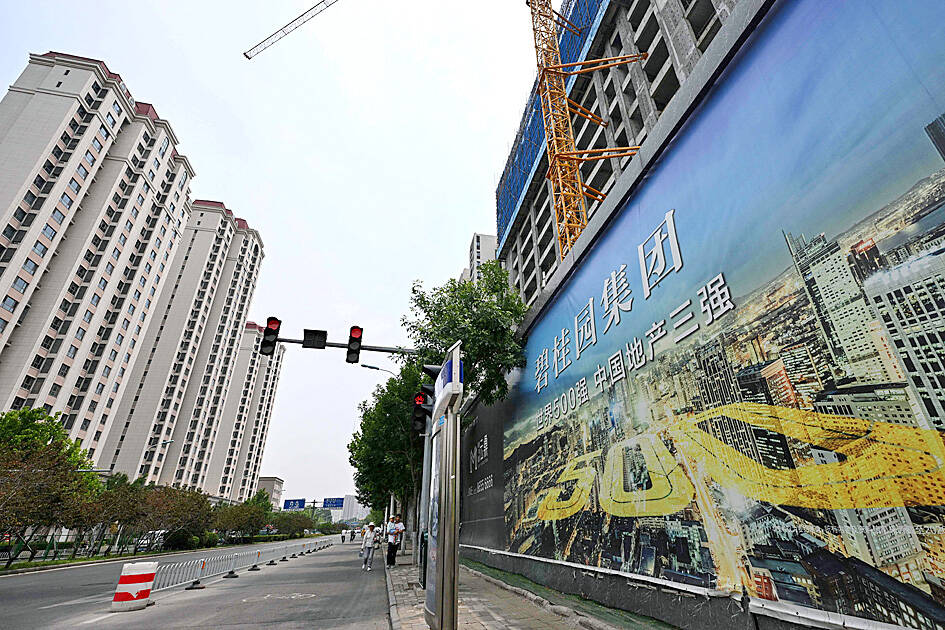Two global credit ratings firms lowered their forecasts for China’s property market, as an accelerating slump in home prices hampers the country’s efforts to rescue the sector.
S&P Global Ratings now expects residential sales to drop 15 percent this year, more than the 5 percent decline it projected earlier. That would put sales below 10 trillion yuan (US$1.4 trillion), about half the peak in 2021, the ratings company said on Thursday.
Fitch Ratings on Wednesday cut its annual sales estimate to a decrease of 15 to 20 percent, worse than an earlier estimate of a 5 to 10 percent drop.

Photo: AFP
The ratings firms’ bleaker outlook suggests they have little confidence that recent stimulus measures would end the property slump that has been dragging the world’s second-largest economy.
The institutions blame a bigger-than-expected drop in home prices, which deters buyers.
Values of new homes fell the most in almost a decade last month, while used-home prices had the sharpest decline in at least 13 years, official figures showed last week.
Real estate accounts for about 78 percent of household wealth in China — double the US rate — and families typically save for years, and borrow from friends and relatives to purchase a home.
Separately, a measure of foreign direct investment (FDI) in China declined for the 12th straight month, underscoring Beijing’s struggle to improve its appeal to overseas investors to boost growth.
Inbound FDI in China dropped 28.2 percent in the first five months of this year from the same period last year to 412.51 billion yuan (US$56.8 billion), data released by the Chinese Ministry of Commerce on Friday showed. The figure was worse than the 27.9 percent drop in April and extended a streak since June last year.
The ministry said FDI fell in January-to-May mainly because of a high comparison base and reiterated authorities have increased efforts to attract foreign investment since the beginning of the year.

JITTERS: Nexperia has a 20 percent market share for chips powering simpler features such as window controls, and changing supply chains could take years European carmakers are looking into ways to scratch components made with parts from China, spooked by deepening geopolitical spats playing out through chipmaker Nexperia BV and Beijing’s export controls on rare earths. To protect operations from trade ructions, several automakers are pushing major suppliers to find permanent alternatives to Chinese semiconductors, people familiar with the matter said. The industry is considering broader changes to its supply chain to adapt to shifting geopolitics, Europe’s main suppliers lobby CLEPA head Matthias Zink said. “We had some indications already — questions like: ‘How can you supply me without this dependency on China?’” Zink, who also

Taiwan Semiconductor Manufacturing Co (TSMC, 台積電) received about NT$147 billion (US$4.71 billion) in subsidies from the US, Japanese, German and Chinese governments over the past two years for its global expansion. Financial data compiled by the world’s largest contract chipmaker showed the company secured NT$4.77 billion in subsidies from the governments in the third quarter, bringing the total for the first three quarters of the year to about NT$71.9 billion. Along with the NT$75.16 billion in financial aid TSMC received last year, the chipmaker obtained NT$147 billion in subsidies in almost two years, the data showed. The subsidies received by its subsidiaries —

At least US$50 million for the freedom of an Emirati sheikh: That is the king’s ransom paid two weeks ago to militants linked to al-Qaeda who are pushing to topple the Malian government and impose Islamic law. Alongside a crippling fuel blockade, the Group for the Support of Islam and Muslims (JNIM) has made kidnapping wealthy foreigners for a ransom a pillar of its strategy of “economic jihad.” Its goal: Oust the junta, which has struggled to contain Mali’s decade-long insurgency since taking power following back-to-back coups in 2020 and 2021, by scaring away investors and paralyzing the west African country’s economy.

The number of Taiwanese working in the US rose to a record high of 137,000 last year, driven largely by Taiwan Semiconductor Manufacturing Co’s (TSMC, 台積電) rapid overseas expansion, according to government data released yesterday. A total of 666,000 Taiwanese nationals were employed abroad last year, an increase of 45,000 from 2023 and the highest level since the COVID-19 pandemic, data from the Directorate-General of Budget, Accounting and Statistics (DGBAS) showed. Overseas employment had steadily increased between 2009 and 2019, peaking at 739,000, before plunging to 319,000 in 2021 amid US-China trade tensions, global supply chain shifts, reshoring by Taiwanese companies and